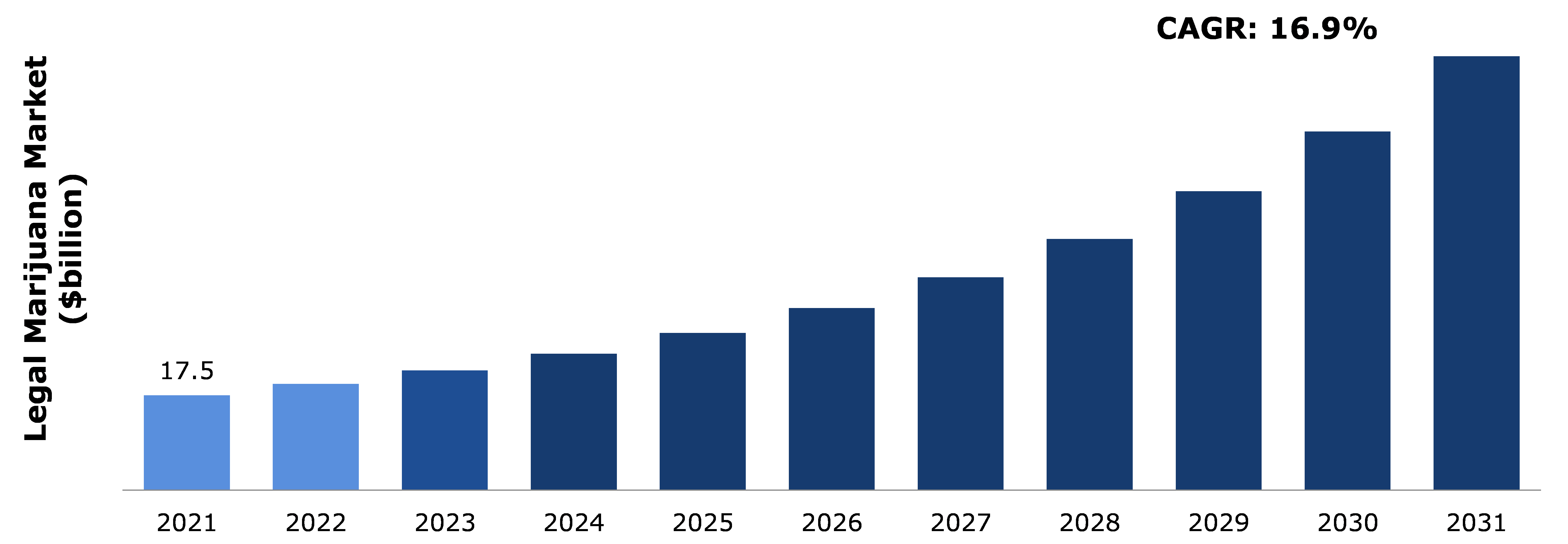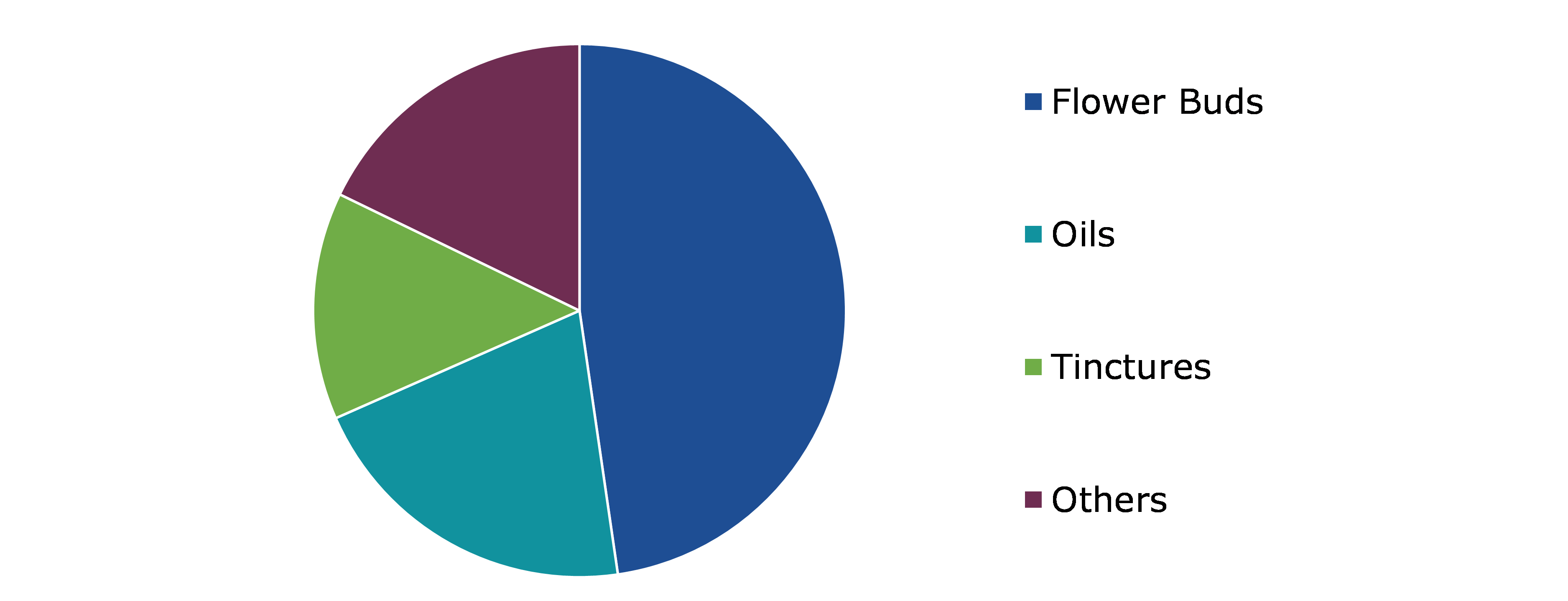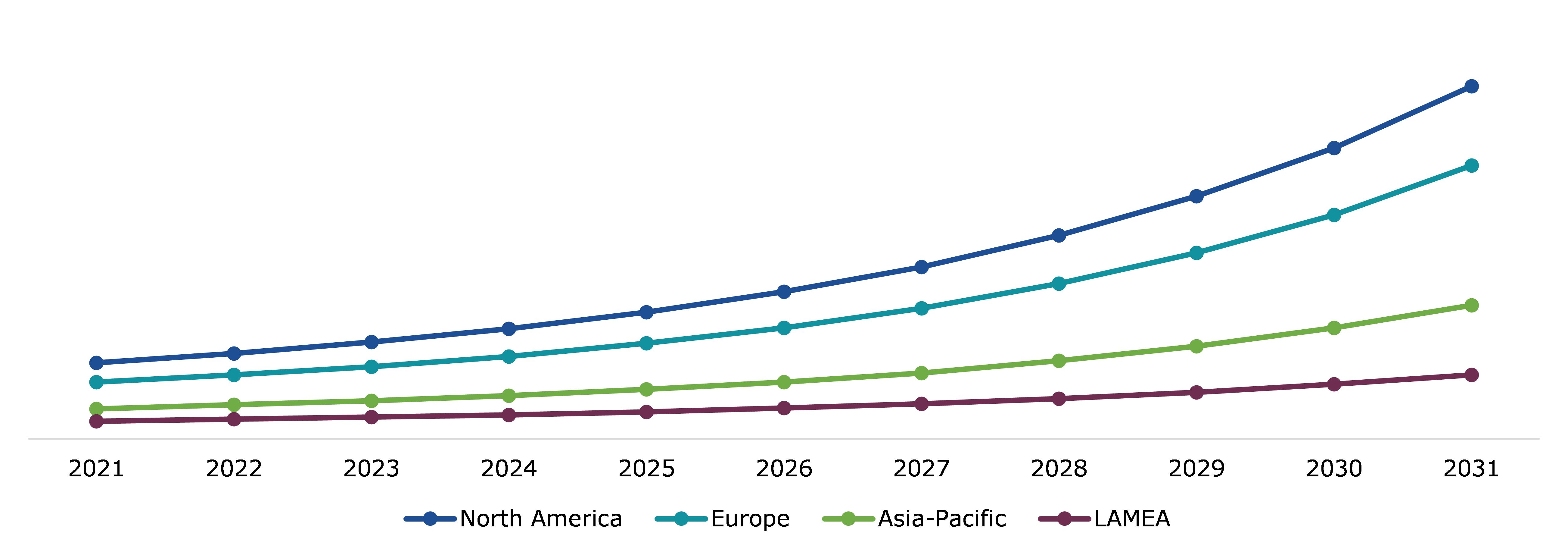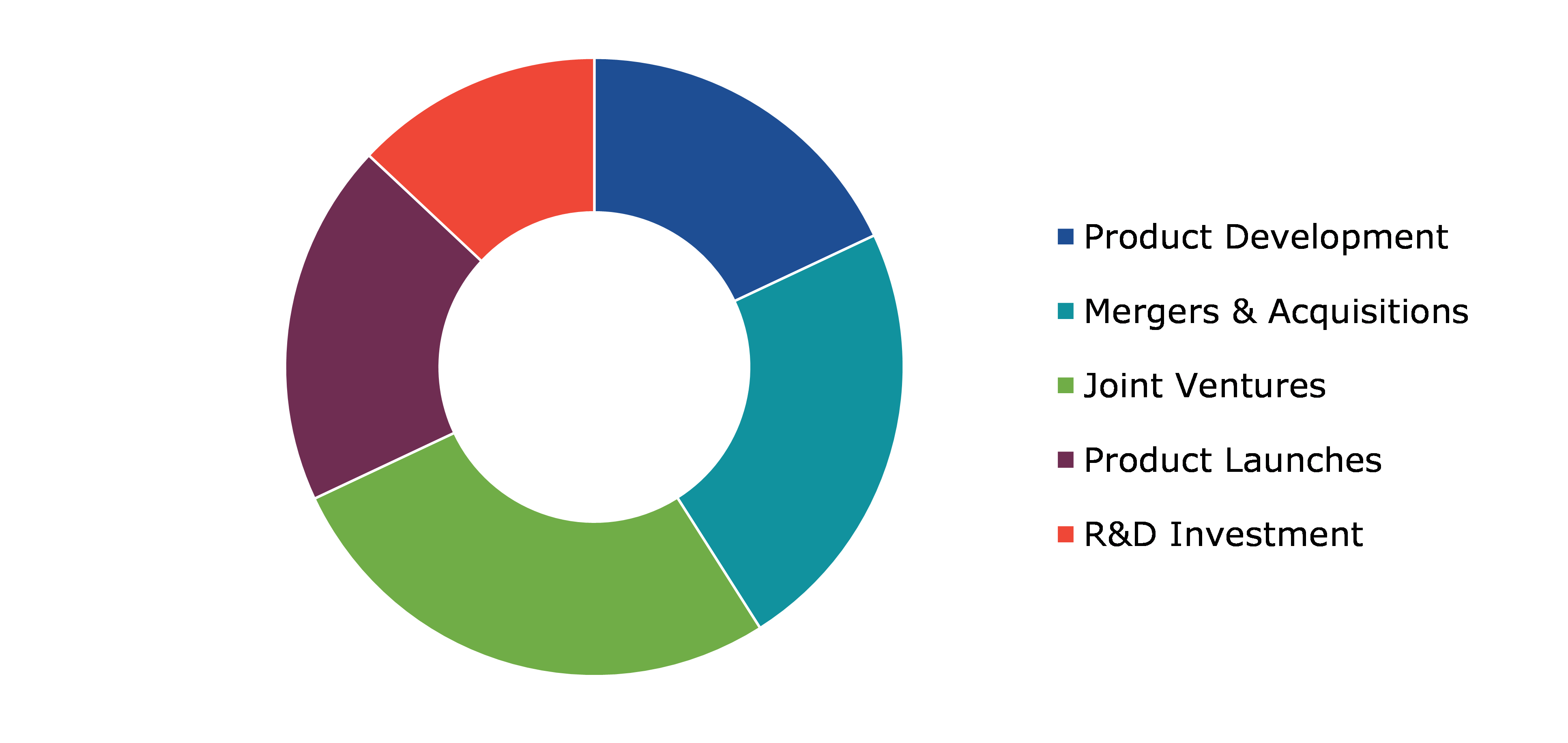Legal Marijuana Market Report
RA08595
Legal Marijuana Market, by Product Type (Flower Buds, Oils, Tinctures and Others) and Application (Recreational and Medical): Global Opportunity Analysis and Industry Forecast, 2022-2031
Global Legal Marijuana Market Analysis
The Global Legal Marijuana Market Size was $17.5billion in 2021 and is predicted to expand at a CAGR of 16.9%, generating a revenue of $80.1 billion by 2031.
Global Legal Marijuana Market Synopsis
The dried green, brown, or grey mixture of marijuana plant pieces is referred to as marijuana. This herb is frequently used as a recreational drug for different types of illnesses. It is being determined in many countries whether marijuana is legal for recreational and medical use, as well as for cultivation, possession, and distribution. Furthermore, growing public understanding of medical marijuana's advantages is going to help the legal marijuana market grow in the coming year. The growing legalization of marijuana for medical purposes in a few countries is anticipated to provide lucrative opportunities to drug cartels, which can propel the marijuana industry’s growth during the forecast period. The fact that marijuana can provide relief from ongoing pain and sleep issues is likely to increase interest in medical marijuana. In addition, a potential surge in demand for organic leaves is likely to result in the increase in demand for marijuana. This will support marijuana trade in the near future.
A number of nations have put stringent restrictions on the use of marijuana due to its unfavorable side effects, which can hurt the medicinal marijuana industry. The recreational use of marijuana is also anticipated to have a detrimental effect on human health, which can hinder the cannabis market growth during the forecast period.
The increase in number of countries that have approved the use of medicinal marijuana in various parts of the world is one of the main causes that are enhancing the rate of cannabis use in therapeutic applications. Protection of public health and safety is one of the other main goals of marijuana legalization in most nations, including Canada. According to the Centre for Addiction and Mental Health (Canada), legalization offers a chance to lessen the negative effects of marijuana usage when accompanied with strict health-focused regulations.
According to regional analysis, the North America market is predicted to expand at the highest CAGR during the forecast period. The market will expand significantly as a result of expanding product legalization and consumer awareness of the product's health advantages.
Legal Marijuana Overview
Marijuana is also known as cannabis. Cannabis sativa plant parts that are dried and shred include leaves, stems, seeds, and flowers. This mixture is known as marijuana (also known as cannabis). Cannabis is utilized as a psychotropic, mind-altering recreational medication as well as a treatment for some conditions. THC is the active ingredient that causes the "high" (delta-9-tetrahydrocannabinol). Marijuana is the substance that is most frequently abused in the U.S., claims the National Institute on Drug Abuse (NIDA).
Many U.S. states have legalized the use of marijuana for medical and/or recreational use or have decriminalized its use. However, according to federal law, the possession of marijuana (cannabis) is still illegal in the U.S., except within approved research settings.
COVID-19 Impact on Global Legal Marijuana Market
The global healthcare industry's workflow was hampered by the COVID-19 pandemic. Numerous industries, including parts of the healthcare industry, were forced to temporarily suspend operations as a result of the infections. In response to the COVID-19 pandemic, many governments throughout the world imposed various types of "lockdowns" to slow the spread of the new coronavirus by preventing or restricting individuals and businesses from doing their normal operations. The lockdown's implementation prevented customers from shopping in physical stores. The legal marijuana market had a prolonged slowdown due to issues such as diminishing product demand from key end users, limited operations in most industries, a disrupted supply chain, and difficulty in providing essential/post-sales services. During this time, many marijuana enterprises began relying heavily on social media and e-commerce channels to reach consumers. Prices for medical marijuana have risen as a result of supply limitations caused by COVID-19-related restrictions and problems with its distribution. Several research institutes and medical marijuana manufacturers partnered to develop a unique vaccination for the treatment and prevention of COVID-19.
For instance, on March 30, 2020, the Alberta government demanded vital services from cannabis retailers, manufacturers, distributors, and warehouses; as a result, cannabis businesses and services continued to provide for Albertans during the COVID-19 pandemic.
Increase in Demand for Cannabis for Medical Applications to Boost Growth
In recent years, medical hemp has drawn a lot more attention from all around the world. As more nations and governments approve its usage for certain medical purposes, it is clear that medical c. sativa use and acceptance are expanding. Due to the therapeutic advantages of marijuana, many nations, including Germany, Finland, Israel, and Canada, have boldly legalized its use for medical purposes. More than 25 U.S. states have amended their legislation to permit the medical use of cannabis. The medicine is effectively utilized by conventional doctors in California and Florida to treat AIDS, anorexia, arthritis, and even cancer. The expansion of the market is anticipated to be fueled by the continuing research and clinical trials for many marijuana-based treatments.
To know more about the global legal marijuana market drivers, get in touch with our analysts here.
Regulations Regarding Usage of Hemp in Different Nations Have Stifled Expansion of the Sector
In some certain area of North America, Africa, Australia, Europe, and South America, marijuana is typically recognized and approved for medical use, while it is still illegal in the majority of Middle Eastern and Asian nations. Consumption, possession, acquisition, or sale of goods that are illegal under the law are considered criminal offences in developing nations like Japan, India, and Korea. As a result, it is anticipated that the legal environment for the product in these areas will prevent the market from growing to its full potential. It is also expected that the negative effects of marijuana use as a drug, which include cognitive impairment, may impede market growth.
Legal Marijuana Offerings Provide Excellent Benefits to Economies on Local and National Scale
Legal marijuana presents the possibility of marvelous benefits to economies on a local and national scale. It also aids in safeguarding the investment holdings of individuals across the nation and abroad. Investors find it challenging to profit from the industry's expansion because marijuana is still banned on the federal level. Though investors do have the choice of working with over-the-counter exchanges, the majority of the most prosperous companies in the early legal cannabis market are based in Canada or other nations. There are very few marijuana-related companies that trade on public stock exchanges.
If marijuana were to be made legal on a federal level, marijuana businesses would be free to list their shares on any market in the U.S., increasing liquidity and expanding investor access. Investors are likely to show a significant interest in the cannabis market if growth rates stay as high as they have in recent years. These factors boost the legal marijuana market opportunities in the coming years.
To know more about the global legal marijuana market opportunities, get in touch with our analysts here.
Global Legal Marijuana Market, by Product Type
On the basis of product type, the market is divided into flower buds, oils, tinctures, and others. Among these, the flower buds segment accounted for the highest legal marijuana market share in 2021, whereas the oils segment is estimated to show the fastest growth during the forecast period.
Global Legal Marijuana Market Statistics, by Product type, 2021
Source: Research Dive Analysis
The flower buds segment accounted for the highest market share in 2021.The smokable, trichome-covered portion of a female cannabis plant is known as the flower, or bud. Due to its adaptability, flower, which may be smoked in a pipe or joint, inhaled in a vaporizer, or used as an ingredient in foods, is the most widely used type of cannabis. Furthermore, the most common consumable commodity on the international market is marijuana flower, or bud. A typical bud contains minor amounts of other cannabinoids as well as 15% to 30% THC, 0.1% CBD, and other cannabinoids. The rationale behind vaporizers, which are quickly gaining popularity, is that the temperatures at which cannabinoids boil are lower than the temperatures at which the flower burns. Sophisticated vaporizers are being designed to maintain temperatures that target the activation of specific cannabinoids.
The oils segment is anticipated to show the fastest growth by 2031.Cancer-related nausea and vomiting are managed using cannabis-derived oils. The oil contains cannabinoids that help cure sleep disorders and lessen stress and anxiety. The legalization of marijuana for recreational use and the rise in the consumption of cannabis and marijuana oil in countries like the U.S., Canada, Colombia, Uruguay, and Chile are driving the growth of the segment.
Global Legal Marijuana Market, by Application
On the basis of application, the market is divided into recreational and medical. Among these, the medical segment accounted for highest revenue share in 2021.
Global Legal Marijuana Market Growth, by Application, 2021
Source: Research Dive Analysis
The medical segment is anticipated to have a dominant market share in 2021 as well as the fastest growth by 2031.The significant market share of the medical sector is mostly attributable to the rise in demand for marijuana as a pain reliever for a range of medical ailments, including cancer, AIDS, seizures, and other disorders, as well as the expansion of marijuana research globally. The recreational application segment is anticipated to rise quickly during the forecast period. This increase is mostly attributable to the rise in consumers following legalization and the trend of using marijuana instead of alcohol. These factors are anticipated to boost the growth of the medical segment during the analysis timeframe.
Global Legal Marijuana Market, Regional Insights
The legal marijuana market was investigated across North America, Europe, Asia-Pacific, and LAMEA.
Legal Marijuana Market Size & Forecast, by Region, 2021-2030 ($Million)
Source: Research Dive Analysis
North America to be the Most Dominant Market for Legal Marijuana
Cannabis legalization has significantly altered the market all over North America. Due to its accessibility, there is a great demand for it, which is reflected in the region's earnings. Its numerous applications in various medical settings for reducing the symptoms of illnesses, including epileptic seizures, chronic pain, Alzheimer's, Parkinson's, and other neurological ailments, have led to its legitimization. Currently, the use of cannabis for therapeutic purposes is legal in 38 U.S. states.
New Jersey became one of the 18 states in the US to legalize recreational marijuana in April 2022. Both recreational and medical marijuana are now available for purchase at 13 locations. Cannabis is widely accepted and in great demand, which is one of the main drivers fueling the market's expansion. Since it became legal, it has becoming more frequently used in medical procedures. This has led to a decline in the illegal cannabis trade, which has also contributed to the growth. According to a study by New York University, the percentage of people aged between 50 to 64 years who use marijuana has increased by 10% over the past ten years.
Competitive Scenario in the Global Legal Marijuana Market
Investments and agreements are common strategies followed by major market players. For instance, in March 2022, the multistate operator of the cannabis industry, Verano Holdings, obtained an additional $100 million under its credit agreement to support expansion and strategic objectives. The vertical medical marijuana company situated in New York, one of the only legal enterprises in that state, will be the acquisition's main asset.
Source: Research Dive Analysis
Some of the leading legal marijuana market players are Aurora Cannabis, Maricann Group, Inc., GW Pharmaceuticals, plc., Aphria, Inc., Tilray, The Cronos Group, ABcann Medicinals, Inc. Canopy Growth Corporation, Lexaria Corp., and Organigram Holding, Inc.
| Aspect | Particulars |
| Historical Market Estimations | 2020 |
| Base Year for Market Estimation | 2021 |
| Forecast Timeline for Market Projection | 2022-2031 |
| Geographical Scope | North America, Europe, Asia-Pacific, LAMEA |
| Segmentation by Product Type |
|
| Segmentation by Application |
|
| Key Companies Profiled |
|
Q1. What is the size of the global legal marijuana market?
A. The size of the global legal marijuana market was over $17.5 billion in 2021 and is projected to reach $80.1 billion by 2031.
Q2. Which are the major companies in the legal marijuana market?
A. Canopy Growth Corporation (Canada), Aphria, Inc. (Canada), Aurora marijuana Inc. (Canada), Maricann Group, Inc. (Canada), and Tilray, Inc. Are some of the key players in the global marijuana market.
Q3. Which region, among others, possesses great investment opportunities for the near future?
A. The North America region possesses great investment opportunities for investors and will witness the most promising growth in the future.
Q4. What will be the growth rate of the Europe legal marijuana market?
A. Europe legal marijuana market is anticipated to grow at 17.7% CAGR during the forecast period.
Q5. What are the strategies opted by the leading players in this market?
A. Agreements and investments are the two key strategies opted by the operating companies in this market.
Q6. Which companies are investing more in R&D practices?
A. Aurora Cannabis and Maricann Group, Inc. are the companies investing more in R&D activities for developing new products and technologies.
1.Research Methodology
1.1.Desk Research
1.2.Real time insights and validation
1.3.Forecast model
1.4.Assumptions and forecast parameters
1.5.Market size estimation
1.5.1.Top-down approach
1.5.2.Bottom-up approach
2.Report Scope
2.1.Market definition
2.2.Key objectives of the study
2.3.Report overview
2.4.Market segmentation
2.5.Overview of the impact of COVID-19 on Global Legal Marijuana market
3.Executive Summary
4.Market Overview
4.1.Introduction
4.2.Growth impact forces
4.2.1.Drivers
4.2.2.Restraints
4.2.3.Opportunities
4.3.Market value chain analysis
4.3.1.List of raw material suppliers
4.3.2.List of manufacturers
4.3.3.List of distributors
4.4.Innovation & sustainability matrices
4.4.1.Technology matrix
4.4.2.Regulatory matrix
4.5.Porter’s five forces analysis
4.5.1.Bargaining power of suppliers
4.5.2.Bargaining power of consumers
4.5.3.Threat of substitutes
4.5.4.Threat of new entrants
4.5.5.Competitive rivalry intensity
4.6.PESTLE analysis
4.6.1.Political
4.6.2.Economical
4.6.3.Social
4.6.4.Technological
4.6.5.Environmental
4.7.Impact of COVID-19 on Legal Marijuana market
4.7.1.Pre-covid market scenario
4.7.2.Post-covid market scenario
5.Legal Marijuana Market Analysis, by Product Type
5.1.Overview
5.2.Flower Buds
5.2.1.Definition, key trends, growth factors, and opportunities
5.2.2.Market size analysis, by region, 2021-2031
5.2.3.Market share analysis, by country, 2021-2031
5.3.Oils
5.3.1.Definition, key trends, growth factors, and opportunities
5.3.2.Market size analysis, by region, 2021-2031
5.3.3.Market share analysis, by country, 2021-2031
5.4.Tinctures
5.4.1.Definition, key trends, growth factors, and opportunities
5.4.2.Market size analysis, by region, 2021-2031
5.4.3.Market share analysis, by country, 2021-2031
5.5.Others
5.5.1.Definition, key trends, growth factors, and opportunities
5.5.2.Market size analysis, by region, 2021-2031
5.5.3.Market share analysis, by country, 2021-2031
5.6.Research Dive Exclusive Insights
5.6.1.Market attractiveness
5.6.2.Competition heatmap
6.Legal Marijuana Market Analysis, by Application
6.1.Recreational
6.1.1.Definition, key trends, growth factors, and opportunities
6.1.2.Market size analysis, by region, 2021-2031
6.1.3.Market share analysis, by country, 2021-2031
6.2.Medical
6.2.1.Definition, key trends, growth factors, and opportunities
6.2.2.Market size analysis, by region, 2021-2031
6.2.3.Market share analysis, by country, 2021-2031
6.3.Research Dive Exclusive Insights
6.3.1.Market attractiveness
6.3.2.Competition heatmap
7.Legal Marijuana Market, by Region
7.1.North America
7.1.1.U.S.
7.1.1.1.Market size analysis, by Product Type, 2021-2031
7.1.1.2.Market size analysis, by Application, 2021-2031
7.1.2.Canada
7.1.2.1.Market size analysis, by Product Type, 2021-2031
7.1.2.2.Market size analysis, by Application, 2021-2031
7.1.3.Mexico
7.1.3.1.Market size analysis, by Product Type, 2021-2031
7.1.3.2.Market size analysis, by Application, 2021-2031
7.1.4.Research Dive Exclusive Insights
7.1.4.1.Market attractiveness
7.1.4.2.Competition heatmap
7.2.Europe
7.2.1.Germany
7.2.1.1.Market size analysis, by Product Type, 2021-2031
7.2.1.2.Market size analysis, by Application, 2021-2031
7.2.2.UK
7.2.2.1.Market size analysis, by Product Type, 2021-2031
7.2.2.2.Market size analysis, by Application, 2021-2031
7.2.3.France
7.2.3.1.Market size analysis, by Product Type, 2021-2031
7.2.3.2.Market size analysis, by Application, 2021-2031
7.2.4.Spain
7.2.4.1.Market size analysis, by Product Type, 2021-2031
7.2.4.2.Market size analysis, by Application, 2021-2031
7.2.5.Italy
7.2.5.1.Market size analysis, by Product Type, 2021-2031
7.2.5.2.Market size analysis, by Application, 2021-2031
7.2.6.Rest of Europe
7.2.6.1.Market size analysis, by Product Type, 2021-2031
7.2.6.2.Market size analysis, by Application, 2021-2031
7.2.7.Research Dive Exclusive Insights
7.2.7.1.Market attractiveness
7.2.7.2.Competition heatmap
7.3.Asia-Pacific
7.3.1.China
7.3.1.1.Market size analysis, by Product Type, 2021-2031
7.3.1.2.Market size analysis, by Application, 2021-2031
7.3.2.Japan
7.3.2.1.Market size analysis, by Product Type, 2021-2031
7.3.2.2.Market size analysis, by Application, 2021-2031
7.3.3.India
7.3.3.1.Market size analysis, by Product Type, 2021-2031
7.3.3.2.Market size analysis, by Application, 2021-2031
7.3.4.Australia
7.3.4.1.Market size analysis, by Product Type, 2021-2031
7.3.4.2.Market size analysis, by Application, 2021-2031
7.3.5.South Korea
7.3.5.1.Market size analysis, by Product Type, 2021-2031
7.3.5.2.Market size analysis, by Application, 2021-2031
7.3.6.Rest of Asia-Pacific
7.3.6.1.Market size analysis, by Product Type, 2021-2031
7.3.6.2.Market size analysis, by Application, 2021-2031
7.3.7.Research Dive Exclusive Insights
7.3.7.1.Market attractiveness
7.3.7.2.Competition heatmap
7.4.LAMEA
7.4.1.Brazil
7.4.1.1.Market size analysis, by Product Type, 2021-2031
7.4.1.2.Market size analysis, by Application, 2021-2031
7.4.2.Saudi Arabia
7.4.2.1.Market size analysis, by Product Type, 2021-2031
7.4.2.2.Market size analysis, by Application, 2021-2031
7.4.3.UAE
7.4.3.1.Market size analysis, by Product Type, 2021-2031
7.4.3.2.Market size analysis, by Application, 2021-2031
7.4.4.South Africa
7.4.4.1.Market size analysis, by Product Type, 2021-2031
7.4.4.2.Market size analysis, by Application, 2021-2031
7.4.5.Rest of LAMEA
7.4.5.1.Market size analysis, by Product Type, 2021-2031
7.4.5.2.Market size analysis, by Application, 2021-2031
7.4.6.Research Dive Exclusive Insights
7.4.6.1.Market attractiveness
7.4.6.2.Competition heatmap
8.Competitive Landscape
8.1.Top winning strategies, 2021
8.1.1.By strategy
8.1.2.By year
8.2.Strategic overview
8.3.Market share analysis, 2021
9.Company Profiles
9.1.Aurora Cannabis
9.1.1.Overview
9.1.2.Business segments
9.1.3.Product portfolio
9.1.4.Financial performance
9.1.5.Recent developments
9.1.6.SWOT analysis
9.2.Maricann Group, Inc.
9.2.1.Overview
9.2.2.Business segments
9.2.3.Product portfolio
9.2.4.Financial performance
9.2.5.Recent developments
9.2.6.SWOT analysis
9.3.GW Pharmaceuticals, plc.
9.3.1.Overview
9.3.2.Business segments
9.3.3.Product portfolio
9.3.4.Financial performance
9.3.5.Recent developments
9.3.6.SWOT analysis
9.4.Aphria, Inc.
9.4.1.Overview
9.4.2.Business segments
9.4.3.Product portfolio
9.4.4.Financial performance
9.4.5.Recent developments
9.4.6.SWOT analysis
9.5.Tilray
9.5.1.Overview
9.5.2.Business segments
9.5.3.Product portfolio
9.5.4.Financial performance
9.5.5.Recent developments
9.5.6.SWOT analysis
9.6.The Cronos Group
9.6.1.Overview
9.6.2.Business segments
9.6.3.Product portfolio
9.6.4.Financial performance
9.6.5.Recent developments
9.6.6.SWOT analysis
9.7. ABcann Medicinals, Inc
9.7.1.Overview
9.7.2.Business segments
9.7.3.Product portfolio
9.7.4.Financial performance
9.7.5.Recent developments
9.7.6.SWOT analysis
9.8.Canopy Growth Corporation
9.8.1.Overview
9.8.2.Business segments
9.8.3.Product portfolio
9.8.4.Financial performance
9.8.5.Recent developments
9.8.6.SWOT analysis
9.9.Lexaria Corp.
9.9.1.Overview
9.9.2.Business segments
9.9.3.Product portfolio
9.9.4.Financial performance
9.9.5.Recent developments
9.9.6.SWOT analysis
9.10.Organigram Holding, Inc
9.10.1.Overview
9.10.2.Business segments
9.10.3.Product portfolio
9.10.4.Financial performance
9.10.5.Recent developments
9.10.6.SWOT analysis
10.Appendix
10.1.Parent & peer market analysis
10.2.Premium insights from industry experts
10.3.Related reports
Marijuana has been used from prehistoric times and is linked with the history of the oldest ancient cultures known to have existed. Since the Narcotic Drugs and Psychotropic Substances Act of 1985, which made the sale and possession of marijuana illegal, the legalization of marijuana has been a contentious issue. Despite this, marijuana remains the most commonly used illicit substance. More and more states have authorized the use of marijuana for medical and recreational purposes.
Marijuana is a psychoactive narcotic drug produced from the flowering tops and leaves of the cannabis Sativa plant, which is vaped, ingested, or smoked for medicinal or recreational purposes. Some nations have legalized marijuana, but other nations still prohibit it. Legalizing marijuana refers to making marijuana distribution, consumption, sale legal, and ownership, especially for medical reasons. Medical marijuana legalization is the process of allowing the use of marijuana plants and its related products to treat a range of illnesses and conditions, such as chronic pain and nausea. The global legal marijuana market is expanding at a rapid pace due to the occurrence of various medical conditions and the efficacy of marijuana for therapeutic objectives.
Newest Insights in the Legal Marijuana Market
The usage of medical marijuana for the treatment of several diseases is accelerating the legal marijuana market growth. Medical marijuana is being given to individuals suffering from chronic illnesses such as Alzheimer's disease, Parkinson's disease, and cancer. As per a report by Research Dive, the global legal marijuana market is anticipated to surpass a revenue of $80.1 billion in the 2022-2031 timeframe. The North America legal marijuana market is expected to perceive foremost and dominant growth in the years to come. This is because the region has a gigantic demand for legal marijuana owing to the growing number of patients with neurological disorders in the region.
How are Market Players Responding to the Rising Demand for Legal Marijuana?
Market players are greatly investing in pioneering research and inventions to cater for the rising demand for legal marijuana. Some of the foremost players in the legal marijuana market are Maricann Group, Inc., Aurora Cannabis, Aphria, Inc., GW Pharmaceuticals, plc., The Cronos Group, Tilray, Canopy Growth Corporation, ABcann Medicinals, Inc., Organigram Holding, Inc, Lexaria Corp., and others. These players are focused on planning and devising tactics such as mergers and acquisitions, collaborations, novel advances, and partnerships to reach a notable position in the global market.
For instance:
- In March 2022, Tilray medicals, a top global cannabis lifestyle and consumer packaged goods firm that encourages and empowers people everywhere to live their best lives, declared their market entry in Malta and introduced the country's first EU GMP medical cannabis oil products. This will help the business to increase its regional presence.
- In March 2022, Martha Stewart, a writer, television host, and American entrepreneur in retail, in partnership with Marquee Brands, one of the world's top brand owners and marketers, and Canopy Growth Corporation, launched the New Tropical Medley Cannabidiol (CBD) Wellness Gummies. Three additional flavours inspired by the rich fruits of tropical destinations are included in the new product offering: Coconut, Pineapple, and Alphonso Mango.
- In June 2022, Canopy Growth Corporation, a global leader in the development of cannabis, hemp, and cannabis-related products, recently launched a brand campaign to raise awareness of its extensive line of cannabis beverages just in time for the summer and the continuous expansion of its cannabis beverage portfolio.
COVID-19 Impact on the Global Legal Marijuana Market
The unpredicted rise of the coronavirus pandemic in 2020 has adversely impacted the global legal marijuana market. During the pandemic period, many countries implemented various "lockdowns" or restrict people and businesses from conducting their regular activity in an effort to stop the spread of the new coronavirus. The legal marijuana market had a significant downturn due to challenges such as declining product demand from important end users, a disrupted supply chain, limited operations in most industries, and difficulty in providing essential/post-sales services. Many marijuana industries started depending extensively on e-commerce channels and social media to reach customers around this time. Medical marijuana prices have increased as a result of supply restrictions brought on the COVID-19-related regulations and issues with its delivery. However, a rise in the number of patients using marijuana as a treatment option is projected in the post-COVID situation.
Personalize this research
- Triangulate with your own data
- Request your format and definition
- Get a deeper dive on a specific application, geography, customer or competitor
- + 1-888-961-4454 Toll - Free
- support@researchdive.com






